Abstract
To evaluate whether expression of cloned genes for the F0 proton channel of the Escherichia coli F1F0 ATPase is sufficient to cause membrane proton permeability, plasmids carrying different combinations of the uncB, E, and F genes, encoding the a, c, and b subunits of the F0 sector, cloned behind the inducible lac promoter in pUC9 or pUC18, were constructed. The effects of inducing F0 synthesis in an unc deletion strain were monitored by measuring cell growth rate, quantitating F0 subunits by immunoblotting, and measuring the ability of membranes to maintain a respiration-induced proton gradient and to bind F1 and carry out energy-coupling reactions. The levels of functional reconstitutable F0 in membranes could be increased four- to sixfold with no change in cellular growth rate or membrane proton permeability (assayed by fluorescence quenching). These results were obtained in uninduced cultures, so the F0 genes were presumably being transcribed from some promoter besides lac. Induction of transcription of all three F0 genes produced increased amounts of F0 subunits in membranes as determined by immunoblot and F1-binding assays, but, when reconstituted with F1, the F0 in membranes isolated from induced cultures was significantly less functional than the F0 in membranes isolated from uninduced cultures. Such induction did result in growth inhibition, but there was no correlation between growth inhibition and either increased membrane proton permeability or the presence of functional, reconstitutable F0.
Full text
PDF
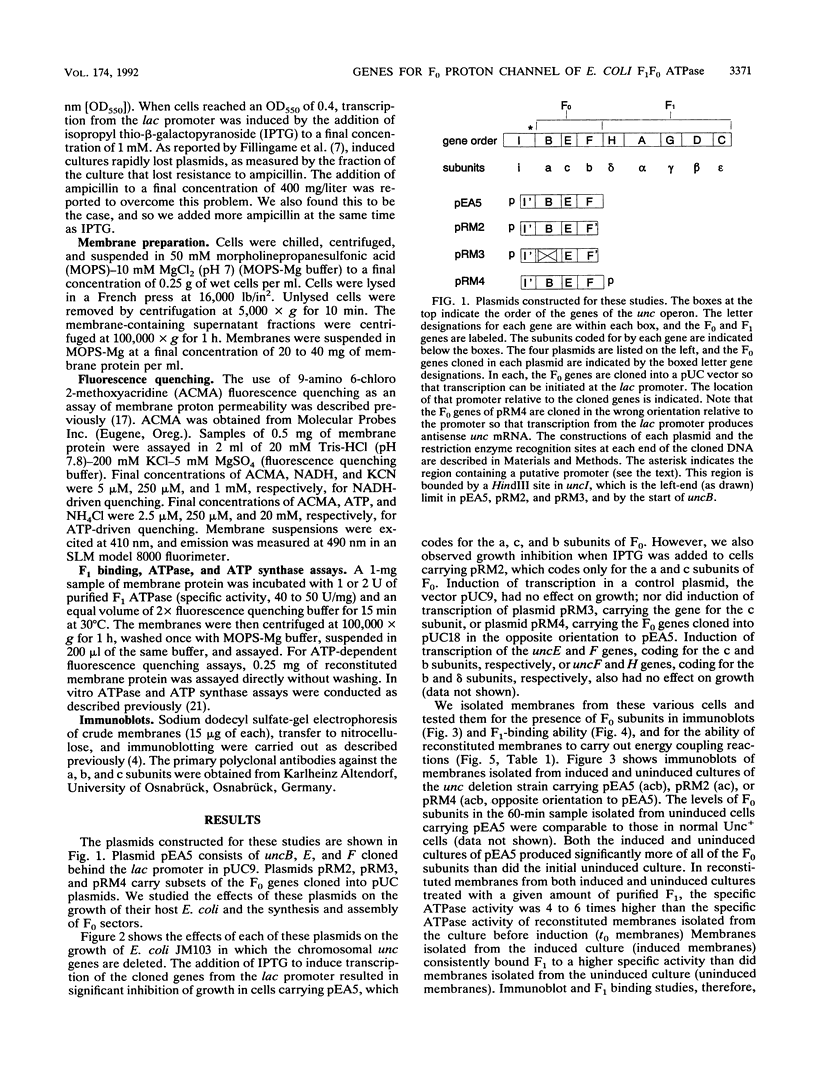
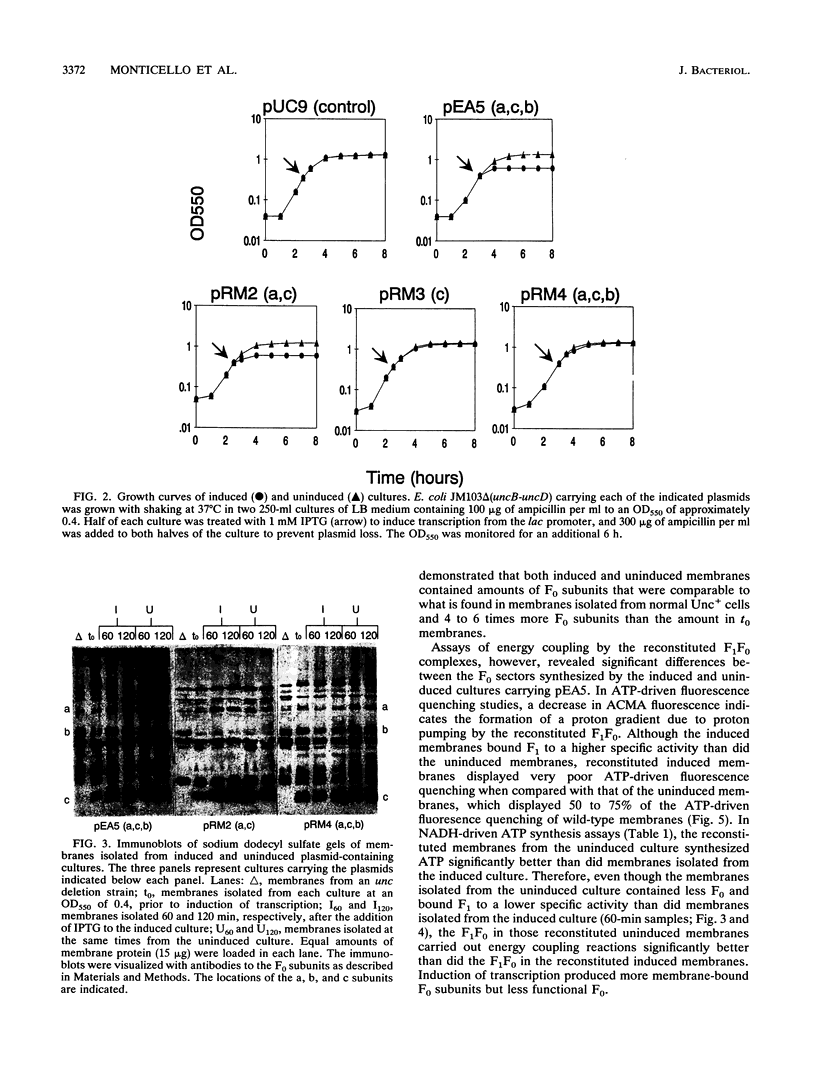
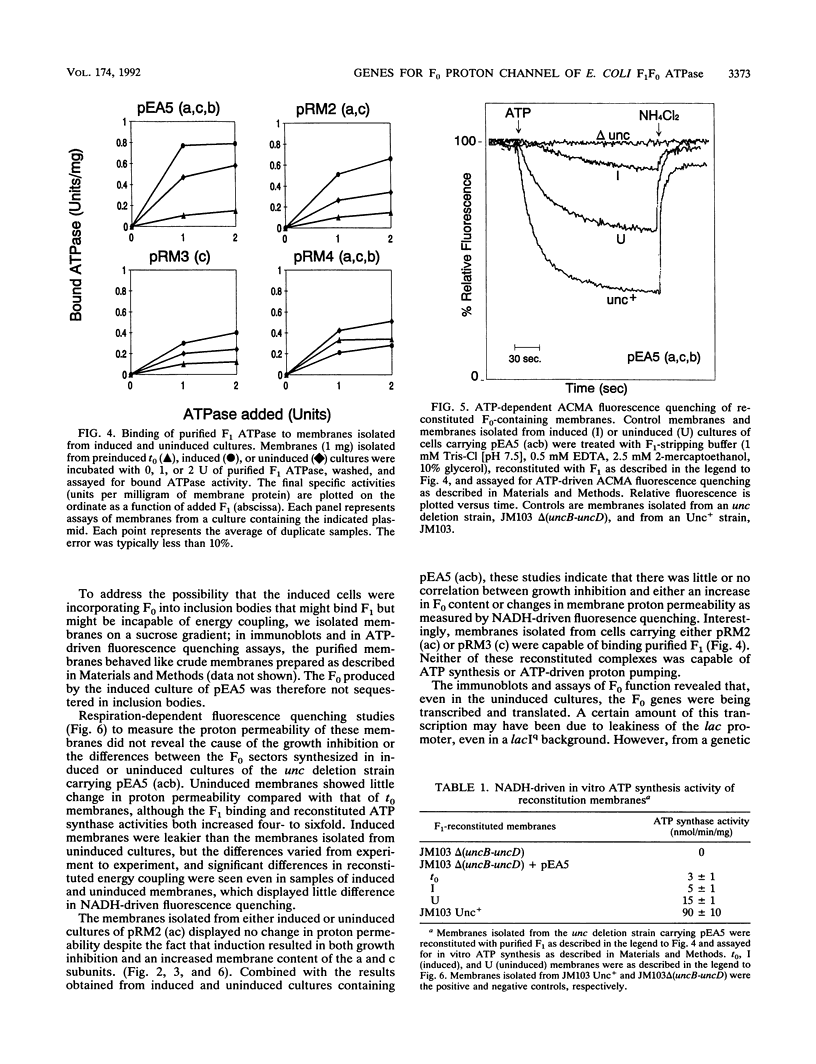
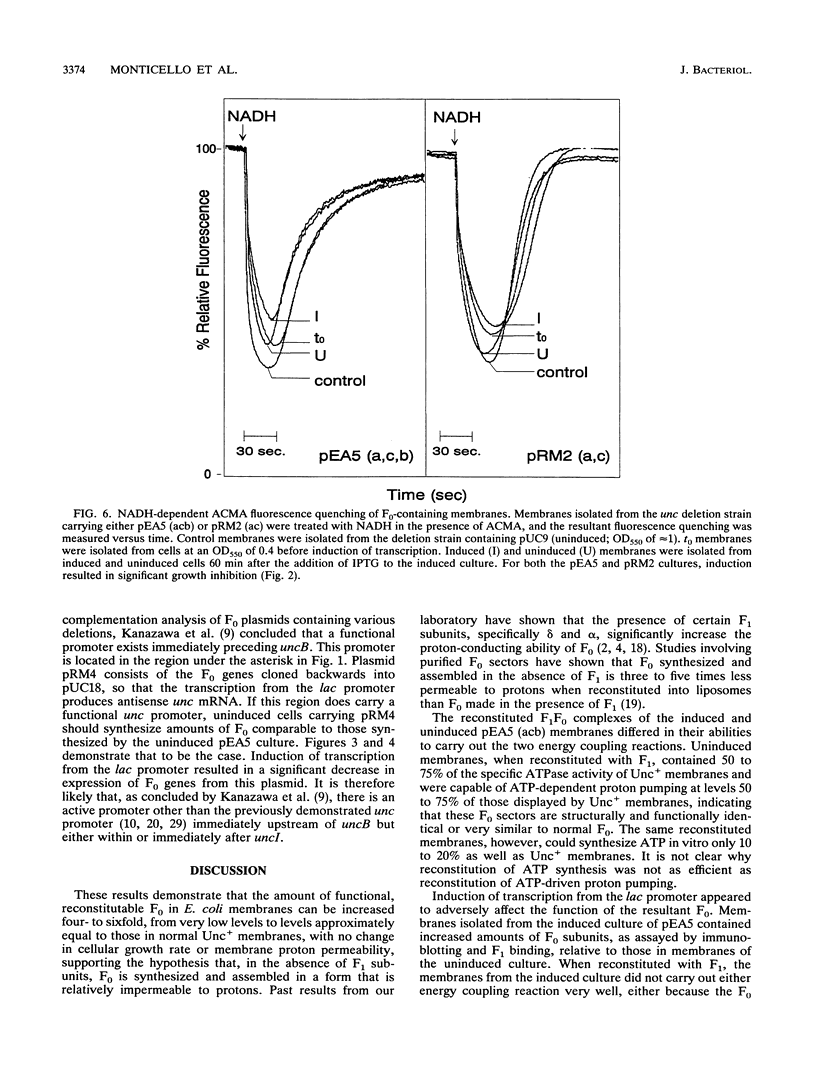
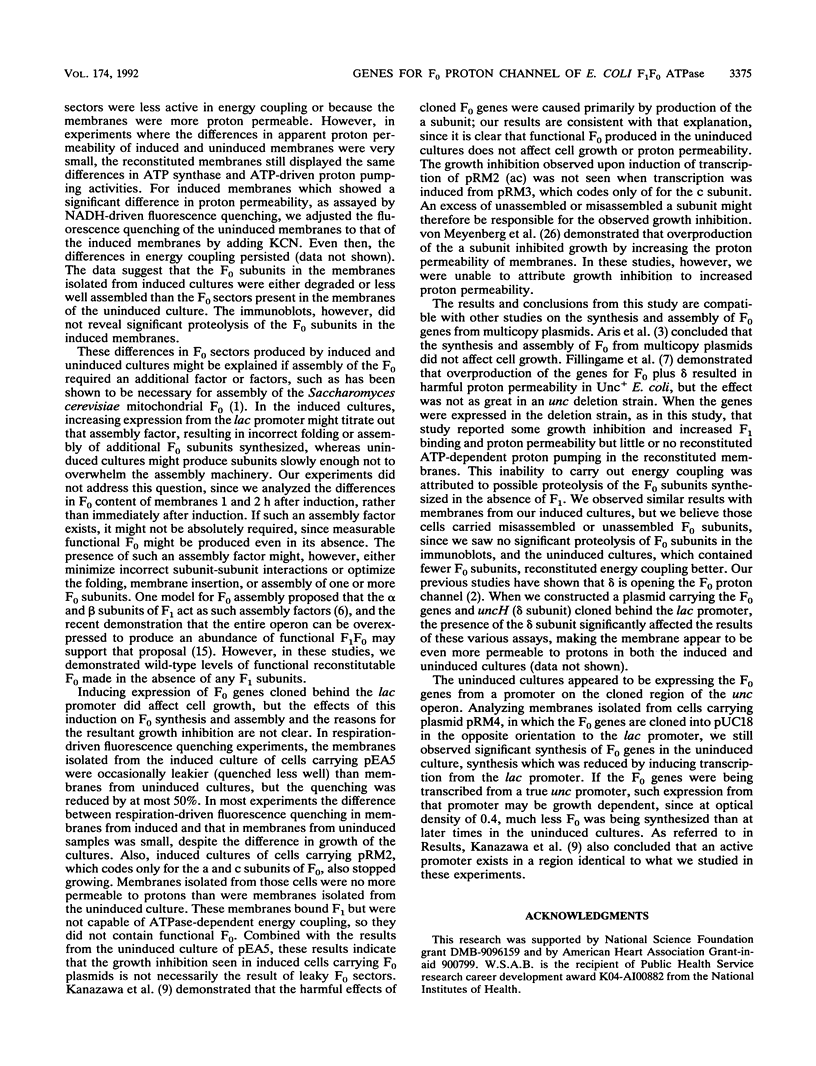
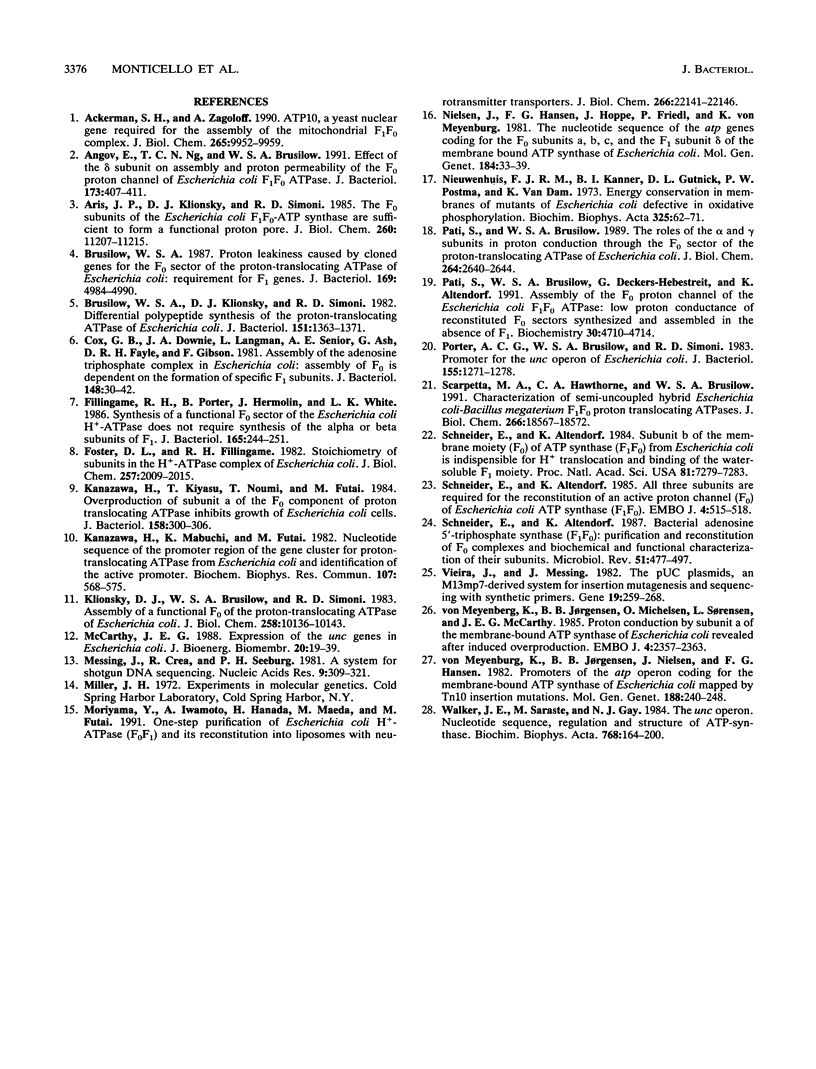
Images in this article
Selected References
These references are in PubMed. This may not be the complete list of references from this article.
- Ackerman S. H., Tzagoloff A. ATP10, a yeast nuclear gene required for the assembly of the mitochondrial F1-F0 complex. J Biol Chem. 1990 Jun 15;265(17):9952–9959. [PubMed] [Google Scholar]
- Angov E., Ng T. C., Brusilow W. S. Effect of the delta subunit on assembly and proton permeability of the F0 proton channel of Escherichia coli F1F0 ATPase. J Bacteriol. 1991 Jan;173(1):407–411. doi: 10.1128/jb.173.1.407-411.1991. [DOI] [PMC free article] [PubMed] [Google Scholar]
- Aris J. P., Klionsky D. J., Simoni R. D. The Fo subunits of the Escherichia coli F1Fo-ATP synthase are sufficient to form a functional proton pore. J Biol Chem. 1985 Sep 15;260(20):11207–11215. [PubMed] [Google Scholar]
- Brusilow W. S., Klionsky D. J., Simoni R. D. Differential polypeptide synthesis of the proton-translocating ATPase of Escherichia coli. J Bacteriol. 1982 Sep;151(3):1363–1371. doi: 10.1128/jb.151.3.1363-1371.1982. [DOI] [PMC free article] [PubMed] [Google Scholar]
- Brusilow W. S. Proton leakiness caused by cloned genes for the F0 sector of the proton-translocating ATPase of Escherichia coli: requirement for F1 genes. J Bacteriol. 1987 Nov;169(11):4984–4990. doi: 10.1128/jb.169.11.4984-4990.1987. [DOI] [PMC free article] [PubMed] [Google Scholar]
- Cox G. B., Downie J. A., Langman L., Senior A. E., Ash G., Fayle D. R., Gibson F. Assembly of the adenosine triphosphatase complex in Escherichia coli: assembly of F0 is dependent on the formation of specific F1 subunits. J Bacteriol. 1981 Oct;148(1):30–42. doi: 10.1128/jb.148.1.30-42.1981. [DOI] [PMC free article] [PubMed] [Google Scholar]
- Fillingame R. H., Porter B., Hermolin J., White L. K. Synthesis of a functional F0 sector of the Escherichia coli H+-ATPase does not require synthesis of the alpha or beta subunits of F1. J Bacteriol. 1986 Jan;165(1):244–251. doi: 10.1128/jb.165.1.244-251.1986. [DOI] [PMC free article] [PubMed] [Google Scholar]
- Foster D. L., Fillingame R. H. Stoichiometry of subunits in the H+-ATPase complex of Escherichia coli. J Biol Chem. 1982 Feb 25;257(4):2009–2015. [PubMed] [Google Scholar]
- Kanazawa H., Kiyasu T., Noumi T., Futai M. Overproduction of subunit a of the F0 component of proton-translocating ATPase inhibits growth of Escherichia coli cells. J Bacteriol. 1984 Apr;158(1):300–306. doi: 10.1128/jb.158.1.300-306.1984. [DOI] [PMC free article] [PubMed] [Google Scholar]
- Kanazawa H., Mabuchi K., Futai M. Nucleotide sequence of the promoter region of the gene cluster for proton-translocating ATPase from Escherichia coli and identification of the active promotor. Biochem Biophys Res Commun. 1982 Jul 30;107(2):568–575. doi: 10.1016/0006-291x(82)91529-7. [DOI] [PubMed] [Google Scholar]
- Klionsky D. J., Brusilow W. S., Simoni R. D. Assembly of a functional F0 of the proton-translocating ATPase of Escherichia coli. J Biol Chem. 1983 Aug 25;258(16):10136–10143. [PubMed] [Google Scholar]
- McCarthy J. E. Expression of the unc genes in Escherichia coli. J Bioenerg Biomembr. 1988 Feb;20(1):19–39. doi: 10.1007/BF00762136. [DOI] [PubMed] [Google Scholar]
- Messing J., Crea R., Seeburg P. H. A system for shotgun DNA sequencing. Nucleic Acids Res. 1981 Jan 24;9(2):309–321. doi: 10.1093/nar/9.2.309. [DOI] [PMC free article] [PubMed] [Google Scholar]
- Moriyama Y., Iwamoto A., Hanada H., Maeda M., Futai M. One-step purification of Escherichia coli H(+)-ATPase (F0F1) and its reconstitution into liposomes with neurotransmitter transporters. J Biol Chem. 1991 Nov 25;266(33):22141–22146. [PubMed] [Google Scholar]
- Nielsen J., Hansen F. G., Hoppe J., Friedl P., von Meyenburg K. The nucleotide sequence of the atp genes coding for the F0 subunits a, b, c and the F1 subunit delta of the membrane bound ATP synthase of Escherichia coli. Mol Gen Genet. 1981;184(1):33–39. doi: 10.1007/BF00271191. [DOI] [PubMed] [Google Scholar]
- Nieuwenhuis F. J., Kanner B. I., Gutnick D. L., Postma P. W., van Dam K. Energy conservation in membranes of mutants of Escherichia coli defective in oxidative phosphorylation. Biochim Biophys Acta. 1973 Oct 19;325(1):62–71. doi: 10.1016/0005-2728(73)90151-5. [DOI] [PubMed] [Google Scholar]
- Pati S., Brusilow W. S., Deckers-Hebestreit G., Altendorf K. Assembly of the F0 proton channel of the Escherichia coli F1F0 ATPase: low proton conductance of reconstituted Fo sectors synthesized and assembled in the absence of F1. Biochemistry. 1991 May 14;30(19):4710–4714. doi: 10.1021/bi00233a011. [DOI] [PubMed] [Google Scholar]
- Pati S., Brusilow W. S. The roles of the alpha and gamma subunits in proton conduction through the Fo sector of the proton-translocating ATPase of Escherichia coli. J Biol Chem. 1989 Feb 15;264(5):2640–2644. [PubMed] [Google Scholar]
- Porter A. C., Brusilow W. S., Simoni R. D. Promoter for the unc operon of Escherichia coli. J Bacteriol. 1983 Sep;155(3):1271–1278. doi: 10.1128/jb.155.3.1271-1278.1983. [DOI] [PMC free article] [PubMed] [Google Scholar]
- Scarpetta M. A., Hawthorne C. A., Brusilow W. S. Characterization of semi-uncoupled hybrid Escherichia coli-Bacillus megaterium F1F0 proton-translocating ATPases. J Biol Chem. 1991 Oct 5;266(28):18567–18572. [PubMed] [Google Scholar]
- Schneider E., Altendorf K. All three subunits are required for the reconstitution of an active proton channel (F0) of Escherichia coli ATP synthase (F1F0). EMBO J. 1985 Feb;4(2):515–518. doi: 10.1002/j.1460-2075.1985.tb03658.x. [DOI] [PMC free article] [PubMed] [Google Scholar]
- Schneider E., Altendorf K. Bacterial adenosine 5'-triphosphate synthase (F1F0): purification and reconstitution of F0 complexes and biochemical and functional characterization of their subunits. Microbiol Rev. 1987 Dec;51(4):477–497. doi: 10.1128/mr.51.4.477-497.1987. [DOI] [PMC free article] [PubMed] [Google Scholar]
- Schneider E., Altendorf K. Subunit b of the membrane moiety (F0) of ATP synthase (F1F0) from Escherichia coli is indispensable for H+ translocation and binding of the water-soluble F1 moiety. Proc Natl Acad Sci U S A. 1984 Dec;81(23):7279–7283. doi: 10.1073/pnas.81.23.7279. [DOI] [PMC free article] [PubMed] [Google Scholar]
- Vieira J., Messing J. The pUC plasmids, an M13mp7-derived system for insertion mutagenesis and sequencing with synthetic universal primers. Gene. 1982 Oct;19(3):259–268. doi: 10.1016/0378-1119(82)90015-4. [DOI] [PubMed] [Google Scholar]
- Walker J. E., Saraste M., Gay N. J. The unc operon. Nucleotide sequence, regulation and structure of ATP-synthase. Biochim Biophys Acta. 1984 Sep 6;768(2):164–200. doi: 10.1016/0304-4173(84)90003-x. [DOI] [PubMed] [Google Scholar]
- von Meyenburg K., Jørgensen B. B., Michelsen O., Sørensen L., McCarthy J. E. Proton conduction by subunit a of the membrane-bound ATP synthase of Escherichia coli revealed after induced overproduction. EMBO J. 1985 Sep;4(9):2357–2363. doi: 10.1002/j.1460-2075.1985.tb03939.x. [DOI] [PMC free article] [PubMed] [Google Scholar]
- von Meyenburg K., Jørgensen B. B., Nielsen J., Hansen F. G. Promoters of the atp operon coding for the membrane-bound ATP synthase of Escherichia coli mapped by Tn10 insertion mutations. Mol Gen Genet. 1982;188(2):240–248. doi: 10.1007/BF00332682. [DOI] [PubMed] [Google Scholar]



